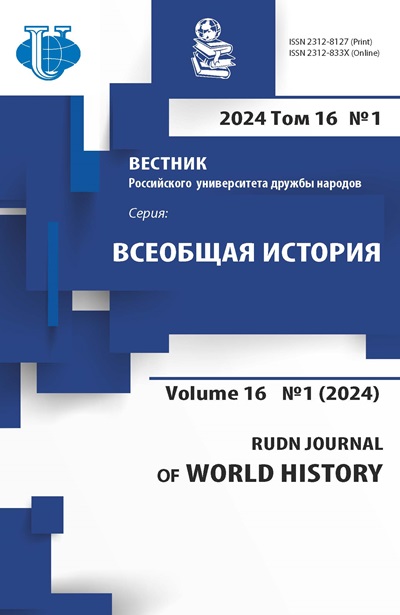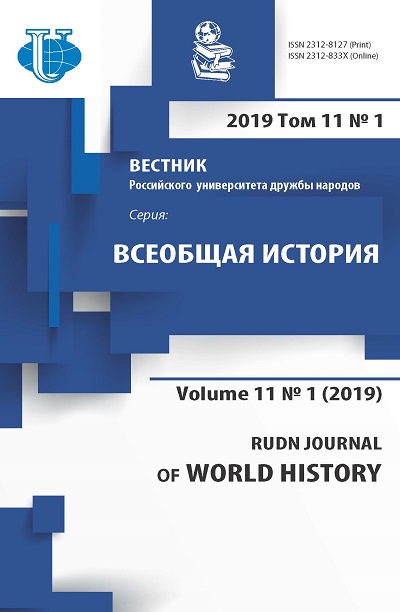Vol 11, No 1 (2019)
- Year: 2019
- Articles: 9
- URL: https://journals.rudn.ru/world-history/issue/view/1266
- DOI: https://doi.org/10.22363/2312-8127-2019-11-1
Full Issue
Ideas and politics in history
Distorted cartography as a reflection of conflicts and political contradictions in the modern world
Abstract
Some features of modern political cartography are analyzed. The authors note that sometimes for the sake of political interests of some international actors, geographic maps, distorted and not responding to modern political realities, are produced. Such false maps mislead the mass audience. The authors emphasize the particular danger of a “war of maps” in regions of heightened conflict, to which, above all, the Middle East and North Africa belong. They conclude that the forged geographic maps, along with the distortion of historical truth and the essence of historical and modern events and processes, become an integral element of a new destructive type of weapons of the 21st century - information confrontation.
 7-15
7-15


Oriental Studies
Beirut under Russian rule. Part 2. The siege and the occupation (1773-1774)
Abstract
During the Russian-Ottoman war of 1768-1774 Russia became the first European country that invaded Middle East in the Modern times and even for the short period occupied its part: the town of Beirut. The events that preceded the assault and capture of the town were fixed by the local chroniclers and Russian officers; as well they were reflected in the messages of Arab rulers and the reports of the diplomats residing in Syria. As a result the volumetric picture of the society is emerging that for the first time faced the colonial expansion of the modernized Europe. The second part of presented article presents the picture of life of the town during the siege of 1773 and its following Russian troops’ occupation, that at first indeed took place, and then imaginary. Special attention is paid to the changes in the system of co-existence of different ethno-religious communities of Beirut.
 16-33
16-33


Ethnic and cultural issues of Uyghurs identity in Xinjiang region
Abstract
The Uyghurs are a Turkic-Muslim minority in the People`s Republic of China (PRC), their native language belongs to a Turkic language family and is written on the basis of Arabic graphics, and regard themselves as culturally and ethnically close to Central Asian nations. This article deals with the issue of the Uyghur identity role in the case of the Xinjiang Uygur Autonomous Region (XUAR) in China and its manifestations in relation to Chinese policy in the region. In order to study this issue the article analyzes the Uyghurs` attitude towards the Han Chinese migrants and their reaction towards Mandarin tuition as well as the salience of Islam faith as a crucial identity marker.
 34-43
34-43


Religion in qirat Qing dynasty politics
Abstract
During 1680s-1750s the Qing dynasty in its relations with the Oirats (Jungars and Khoshuts) actively used the potential and significance of Buddhism to achieve its main goal - the subordination of these nomads. At the same time, it had acted as a peacemaker and legislator, seeking to put under dynasty’s control not only the Oirat-Tibetan relations, but also the education of the Oirat lamas, and had tried to get them for their education in the Beijing Buddhist monasteries. In case of overt or covert insubordination, Beijing usually accused Oirat rulers in their rejection of Buddha’s teaching and conversion to Islam, claiming itself to be the only true defender of the teachings of Geluk school and personally the Dalai Lama. Such a policy, along with a complex political process in Tibet, and the Oirat internal strife, had had its impact on the crisis in the Oirat community in the middle of XVIII century.
 44-55
44-55


Dialogue of civilizations
Features of the Russian-Egyptian cross-cultural communication: business and management dimensions
Abstract
The article considers the importance of cross-cultural competence for the Russian-Egyptian economic and business interaction. A historical overview of bilateral relations is made with an emphasis on trade. However, in today’s globalized world communication between representatives of such two different cultures as Russia and Egypt can no longer rely upon traditional approaches. The choice in favour of the Russian-Egyptian interaction is determined by the following factors: 1) both countries are regional leaders - Russia is a locomotive of Eurasia and the leader of various political and economic processes at the post-Soviet space, while Egypt is both “heart and mind” of the Arab world, being a traditional architect of development in the Middle East and North Africa; 2) Russia traditionally has geopolitical interests in this part of the world, while Egypt has strong intention to diversify its international liaisons by including the Russian Federation into the circle of its strategic partners; 3) Russian-Egyptian relations enjoy a long and profound history; 4) Russian-Egyptian cooperation is currently being realized on a wide scale and includes political, military, economic, cultural, scientific, educational, social even religious spheres. Psychological challenges of the Russian-Egyptian business interaction are illustrated on both empirical and theoretical material: the first is shown by the examples from the work of the RussianEgyptian Business Council. The second level is represented by the two theoretical concepts: 1. of M-time and P-time cultures elaborated by the prominent American anthropologist Edward Hall; 2. Long-Term Orientation dimension suggested by famous Dutch researcher Geert Hofstede.
 56-64
56-64


Africans in China and its influence for China-Africa relations
Abstract
Recent years, steadily growing China’s influence on Africa. Africa is often called “China’s second continent”, which is associated with an enhanced Chinese presence on the African continent. However, the question of the presence of Africans in China and the influence on the development of Chinese-African relations, which will be the subject of this article, remains little studied. This topic is of particular interest because of the initiative of the PRC President Xi Jinping to create the Center for Innovative Cooperation between China and Africa to promote innovation among youth and entrepreneurship, voiced during the China-Africa Cooperation Forum (FOCAC) held in Beijing in early September 2018. In this article, the author will highlight the important historical events of the development of the Chinese-African dialogue, consider the main cities with a high percentage of the African population, identify the reasons for the presence of Africans in China and the impact on the development of cooperation between the parties.
 65-75
65-75


Antique world
Pax Romana and the Roman “imperialism” in the 1st century A.D
Abstract
This article is devoted to such a historical phenomenon as the Roman “imperialism” in the epoch of Augustus and his coming successors. Despite the fact that the founder of the Principate had declared the coming of “pax Augusta”, he spent several wars of conquest (for instance, in Spain and Germany). But Tiberius had already refused of “aggressive imperialism”, then the Empire moved to defense at all frontiers. The emperors of the 1st century A.D. only from time to time took offensive actions (for example, in Armenia or Britain). Probably, there were two reasons for the Romans’ rejection of expansion policy. First of all, by that moment they had already conquered practically all the Mediterranean, and the expanding of the boundaries of the Empire hadn’t sense any more. Secondly, the creation of professional army led to the noticeable decline of the militarization level of the Roman society, which from that on was keenly interested in the keeping of peace and stability all over the “pax Romana”.
 76-90
76-90


Part orgeones in financing religious ceremonies in Attica IV century B.C. (according to epigraphy)
Abstract
The article is devoted to participation orgeones (religious communities) in the organization and financing of the research Institute of religious ceremonies in Athens IV century BC, the Primary source on this issue is epigraphic material - inscriptions, preserved on a marble stele dedicated to economic activities organov. These religious communities received from the Athenian policy the right to dispose of the sacred land, leased temple sites (Temenos) , and in some cases organized their sale, receiving a certain income. In addition, the bodies included wealthy citizens who made donations and sponsored the activities of the Association. These funds were used to organize the internal activities of the community, as well as to organize and Finance various religious ceremonies, which were held in the community and on the territory of the Athenian Polis.
 91-100
91-100


Archaeological studies
Medieval ceramics made on a potter’s wheel of Murzaly in the Eastern Aral Sea region
Abstract
The article is devoted to the study of glazed and non-glazed medieval ceramics made on a potter’s wheel, the settlement of Murzaly in the territory of the Eastern Aral sea region. The features of its manufacturing technology, forms, ornamentation are highlighted, a comparative typology is carried out. The easel ceramics of the Murzaly settlement were made on a fast-spinning foot wheel and have pottery roasting. It is represented by ornamented and non-ornamented homas, pots, wide-necked and narrow-necked pots, jugs, bowls, dishes, bowls, mugs, lamps, etc. The easel ceramics of the Murzaly settlement are generally similar to the Khorezm XII-XIV centuries and refers to the time of the highest economic prosperity and political power of Khorezm.
 101-110
101-110
















